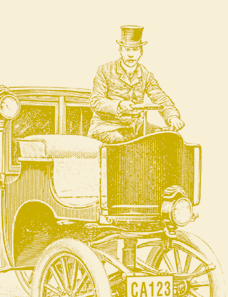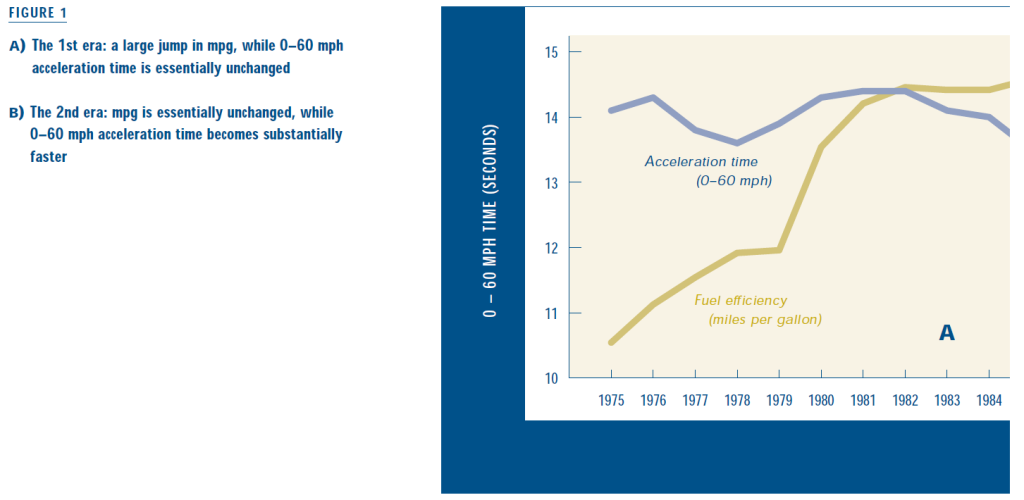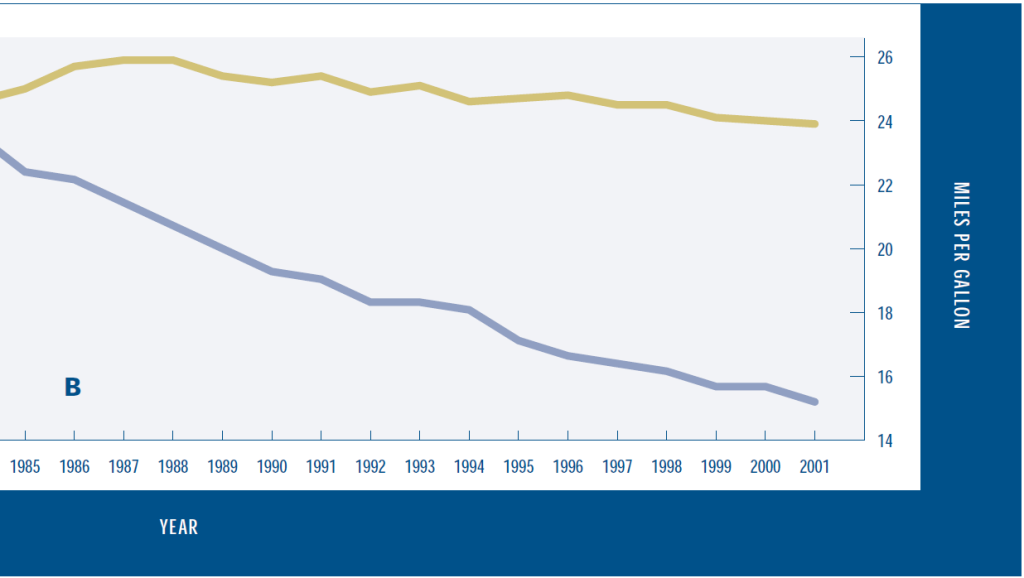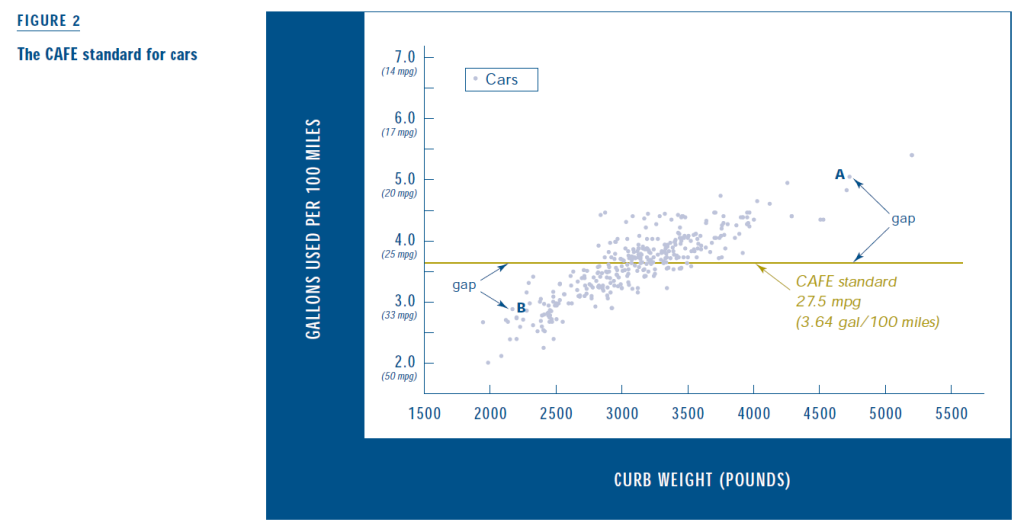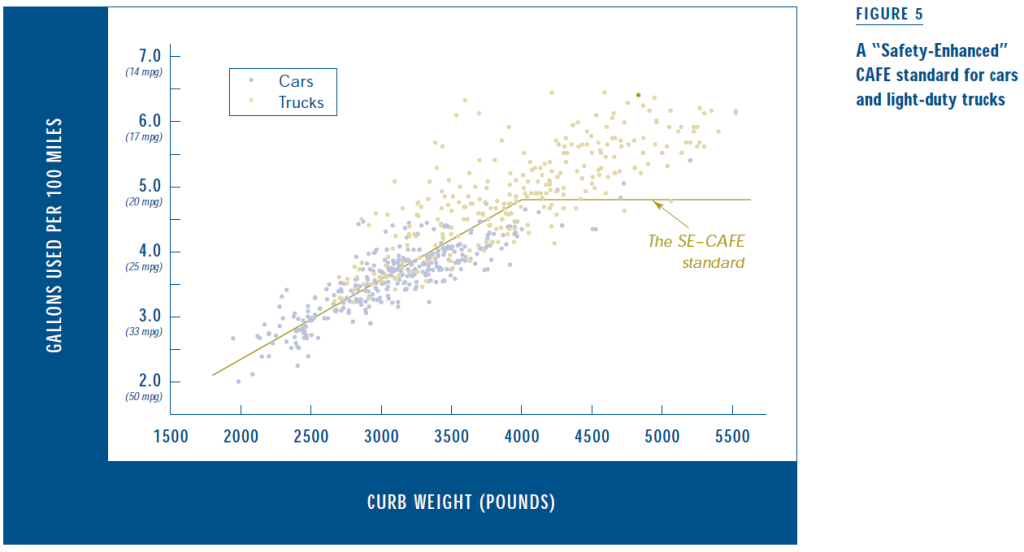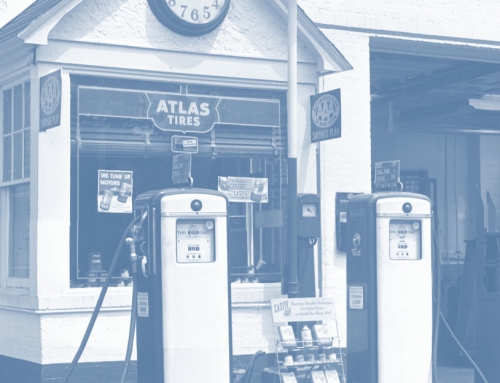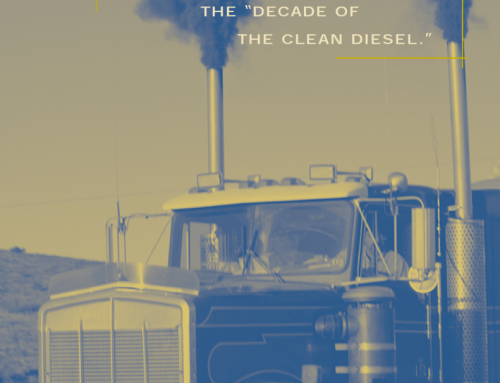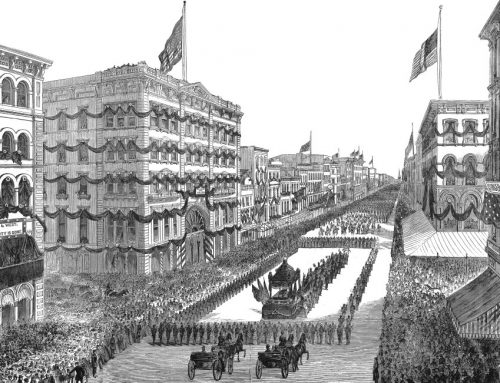[sharelines]Changing how CAFE standards are measured will lower fuel consumption and improve safety.
Over the past six months, a National Academy of Sciences panel has been working intensively on a congressionally mandated evaluation of federal regulations on fuel economy in cars. The panel concluded that significant, cost-effective, safety-enhancing improvements were possible. Its report received extensive peer review and was published under the aegis of the National Research Council in a report titled “Effectiveness and Impact of Corporate Average Fuel Economy (CAFE ) Standards.” I was a member of that panel and in the following two essays, I want to review of some of the issues raised in its deliberations. The analytic material comes from the panel’s report; the opinions are my own.
Part I
Size and Speed:
Two Races Society Can’t Win
Over the last fifteen years, the cars and trucks we use for personal transportation have become bigger and faster. Is that good or bad? Consider an analogy: suppose I’m in a sports stadium, and I stand up to get a better view. This blocks your view, so you have to stand up too. Pretty soon everyone is standing, everyone is uncomfortable, and no one has a better view.
Back to the highway. I can’t see around the tall vehicles I encounter on the road, so I decide to get a taller vehicle myself. The idea spreads broadly. We all need to defend our ability to see down the road, but we don’t end up any better off.
We play out a similar race with vehicle speed: I want to peel out from the stop light faster than you, so I get a more powerful car; you respond by getting a more powerful car, too. Eventually all cars are more powerful, but there is still only one winner per stop light.
Some of these competitions have serious side effects. I can buy a big SUV to protect myself against other people in big SUVs. But all those who decline this competition are in danger of being crushed like eggshells in an unexpected meeting with my SUV. It’s a losing proposition for society as a whole: the extra danger for those who drive normal cars is greater than the extra safety for those who buy SUVs. And conversely, reducing 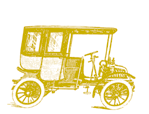 the weight of SUVs would have only a small safety effect on SUV drivers, but would save a lot of lives among other drivers—not to mention pedestrians and cyclists.
the weight of SUVs would have only a small safety effect on SUV drivers, but would save a lot of lives among other drivers—not to mention pedestrians and cyclists.
Sometimes society intervenes in these kind of races. Most beach communities, for example, have enacted building height limits to control the futile competition for views. And although I could make my house somewhat safer if I were to install an electrified fence, most communities have laws that prevent me from doing this because the danger to society as a whole is greater than the benefit to me.
The point is this: there is precedent for regulations that limit consumer choice in these sorts of races and it might be reasonable for Congress to pass regulations that rein in the size and power race. The existing fuel-economy regulations (called Corporate Average Fuel Economy, or CAFE) did so indirectly by demanding that each company’s vehicle fleet achieve a certain average fuel economy level. During its first ten years, CAFE acted as an indirect regulation on weight and size. But eventually technology improved enough to make the CAFE regulations easy to meet, freeing the automakers to increase size and power. Thus one possible way of dealing with the size / power race is to revise the fuel economy standards. (Part II of this essay, “A Safety-Enhanced CAFE Standard,” suggests one possible revision that would accomplish this.)
The Broad Picture: How We Got Here
Some instructive lessons can be learned from the period before the first oil embargo in 1973–74. There was a size and horsepower competition then too: satirists poked fun atthe race, speculating about “the new Belchfire V-16”; Terry Southern, in The Magic Chri stian, described wondrous new car models as big as yachts, so big they had trouble navigating corners in New York.
That oil embargo forced a bit of global perspective on us. Congress reacted by mandating CAFE regulations that required auto companies to radically improve the fuel economy of their cars and trucks. Fortunately, engineers were able to meet the challenge by making technological improvements in the efficiency of vehicle aerodynamics and drivetrains.
Automotive technology continues to improve—consider it a dividend from the large expenditure society makes in science and engineering. This technological dividend can be spent on three kinds of vehicle changes: better fuel economy, bigger size, or faster acceleration.
During its first ten years, CAFE directed the technology dividend toward fuel economy. During the last fifteen it has permitted the competition for speed and size. The big question is: How shall we spend this technology dividend in the future? Consider the past first.
The 1st Post-Opec Era: Technology To The Rescue
How did the auto companies react to the CAFE regulations? Between 1975 and 1984 the fleetwide average over all cars and light-duty trucks rose from 15.3 mpg to 24.6 mpg, a 61 percent improvement. Most people think this was accomplished by reducing performance, making vehicles more anemic. Figure 1A shows what happened to mpg and to performance, as measured by the time required for a vehicle to accelerate from zero to sixty mph. The curves show that acceleration ability remained essentially constant while fuel economy took a big upward leap.
How was this possible? The major source of the increase, the hero of our story, was new technology—engineering improvements like front wheel drive, more efficient engines, and improved aerodynamics. And this was done with no sacrifice in performance. (The zero-to-sixty-mph acceleration time of the average vehicle actually improved slightly, from 14.1 to 14 seconds.)
Some of the mpg increase came about through down-weighting, but not much. Between 1975 and 1984, the average vehicle became twenty percent lighter. A reasonable rule of thumb is that each one percent reduction in weight produces a 1.66 percent improvement in fuel Thus we can partition the 61 percent overall mpg improvement: 13 percent was due to weight reduction, 48 percent to improved technology.
The 2nd Post-Opec Era: The Engineers Giveth and the Marketeers Taketh Away
Technology continued to improve after 1984. Drivetrains and aerodynamics became even more efficient. How were these efficiency improvements used? Having essentially achieved the mandated fuel consumption targets at this point, and hence no longer constrained by CAFE, the auto industry resumed the race for size and power.
Figure 1B shows mpg and performance trends during this second era. Between 1985 and 2000, the average mpg of the new vehicle fleet was essentially constant, but acceleration times became 33 percent faster. That is, the improvements in technological efficiency were devoted to increased size and performance. They could have been used to improve mpg, but they weren’t. We have no way to know motives, but some critics have speculated that the marketing staff at one company decided it could increase vehicle sales by telling consumers that they needed more “zoom, zoom.” Of course, such success is temporary at best. It’s ironic that auto companies, themselves, ended up in a race for relative position.
The 3rd Post-Opec Era: It’s Up to Us—What Will We Choose?
What happens next? In July 2001, the National Academy of Sciences mapped out one possible technological path, projecting future fuel economy based on the following somewhat conservative restrictions. The report considered only those technologies that:
- were already proven;
- could pay for themselves over the lifetime of the vehicle; and
- would not reduce either weight or acceleration.
The NAS panel found that, even given these restrictions, the mpg of cars could be improved by 16 to 37 percent, and the mpg of SUVs and light trucks could be improved by 26 to 45 percent.
Things might happen that way. We know that automotive technology will continue to improve. But we don’t know how this improvement will be applied: better fuel economy, bigger size, or faster acceleration? The CAFE law can act like a traffic cop, directing the technology dividend among these three possibilities.
We will continue to enjoy improvements in technology. How shall we put them to work? Do we continue the inherently futile race for relative acceleration, relative view-blocking ability, and relative car-crushing ability? Or do we agree in advance that we would be better off, collectively, if we got out of this unwinnable race, and spent the technology dividend to improve fuel economy?

Part II
A Safety Enhanced CAFE Standard:
Better Things for Better Living Through Measurement
Measurement systems create incentives. When the results of a measurement determine eligibility for some special status or reward, you can bet  that people will alter behavior to move their measurement toward eligibility. For example, about a decade ago, medical schools began making part of their admissions decision based on evidence of students’ public-spirited activities outside the classroom. Soon I was seeing student resumes that would have made Mother Teresa proud. That is, the act of measurement causes changes in the behavior being measured. It’s the Heisenberg Uncertainty Principle applied to people.
that people will alter behavior to move their measurement toward eligibility. For example, about a decade ago, medical schools began making part of their admissions decision based on evidence of students’ public-spirited activities outside the classroom. Soon I was seeing student resumes that would have made Mother Teresa proud. That is, the act of measurement causes changes in the behavior being measured. It’s the Heisenberg Uncertainty Principle applied to people.
Twenty-six years ago the federal government decided to regulate the fuel economy of cars and trucks. The measurement system it created, the Corporate Average Fuel Economy standards, or CAFE, produced a lot of good results—and some undesirable ones too. Now, with Congress thinking about changing the standards, it’s important to take the opportunity to change the measurement system as well.
fuel economy of cars and trucks. The measurement system it created, the Corporate Average Fuel Economy standards, or CAFE, produced a lot of good results—and some undesirable ones too. Now, with Congress thinking about changing the standards, it’s important to take the opportunity to change the measurement system as well.
I want first to describe the current measurement system and its perverse outcomes, and then to suggest a replacement for it that could reduce fuel consumption and make a major improvement in the vehicle fleet’s overall safety.
For the moment, leave aside the question of whether or not there should be fuel consumption targets. Take that as a given and ask: “Can we do a better job of it? Can we improve CAFE?” A recent panel of the National Academy of Sciences took up these questions and came up with a number of significant improvements; this article is excerpted from Chapter 5 of the NAS report. But before we talk about improvements, let’s try to understand the problems with the current CAFE system by examining how it operates.
The Current CAFE System
Figure 2 shows how CAFE works now. Each dot is a specific passenger car model—for example, the four-cylinder Accord and the six-cylinder Accord are separate marks. The horizontal axis shows car weight; cars on the right-hand side weigh more and use more fuel than those on the left.
The vertical axis shows fuel consumption. Instead of measuring in miles per gallon, it measures the amount of gasoline each car needs to travel 100 miles, e.g., a car that gets 25 mpg needs 4 gallons to drive 100 miles. The horizontal line shows the current CAFE standard, which is 27.5 mpg, or 3.64 gallons per 100 miles on the vertical axis. It applies to the average car a company makes, so a manufacturer producing gas-guzzlers can balance them by also selling very fuel-efficient models.
Vehicle A uses more fuel than is allowed by the CAFE standard. The gap between A and the CAFE line is the amount of excess fuel use. Vehicle B uses less fuel than the CAFE standard. The gap between B and the CAFE line is not as large, so the manufacturer who makes both As and Bs will have to sell approximately two Bs to offset the high fuel consumption of one A.
There are also differences among manufacturers. Some have a product mix that emphasizes light- and medium-weight cars—these manufacturers found it cheap and easy to meet the CAFE standards. Other manufacturers were producing a mix that was more toward the right side of the curve, and they had to spend a considerable amount of money to develop and sell lighter cars so they could create enough CAFE credits to bring their total fleet into compliance.
These problems arise in part because the CAFE standards hold all cars to the same fuel economy target regardless of their weight, size, or load-carrying capacity. We could avoid them by developing a new measure that responds to differences in vehicle attributes, such as weight, for example.
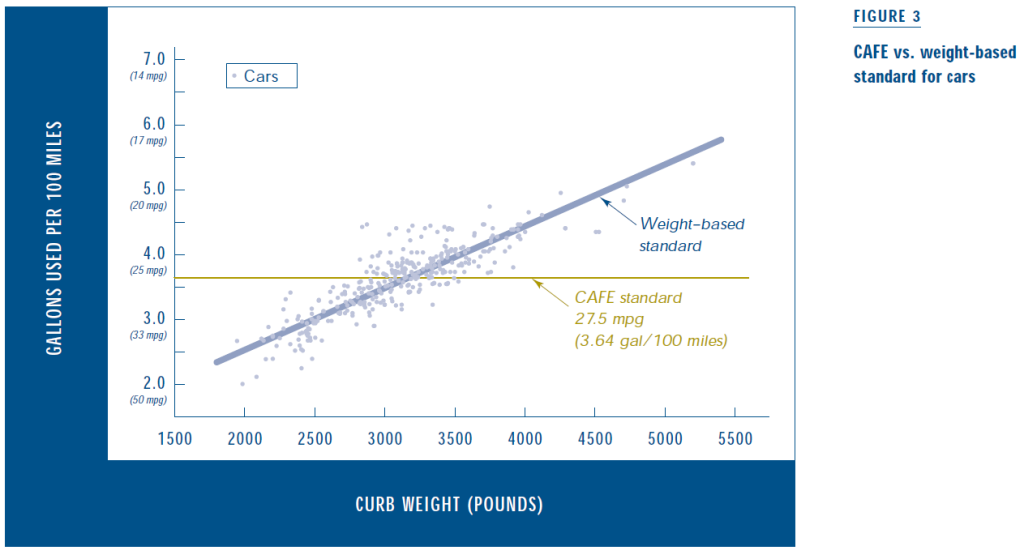
The blue, upward sloping line in Figure 3 shows the average relationship between vehicle weight and fuel consumption. It is obviously a very good fit . A weight-based CAFE system would use such a line for fuel economy targets, rather than the current horizontal line stuck at 27.5 mpg, or any other measure.
Unfortunately, weight-based targets have three major disadvantages. First, because they are weight-neutral, a principal lever for influencing fuel economy is lost. Second, they remove most of the incentive behind current research programs pursuing the use of lightweight materials as substitutes for steel— research that has potentially important safety benefits, because new materials allow vehicles to be lighter while maintaining current crush-space.
Third, and most important, weight-based standards could result in higher fuel consumption. Unlike CAFE, there would be no cap on the fleet average, so the average vehicle could move to the right on the curve (that is, get heavier). Is this likely?
Note that car weights and truck weights have been increasing over the past decade despite strong counteracting pressure from CAFE. Furthermore, the profit margin associated with large vehicles has traditionally been much higher than that associated with small ones. Thus there are substantial market incentives for manufacturers to increase vehicle weights and no restraints on them doing so once CAFE is removed.
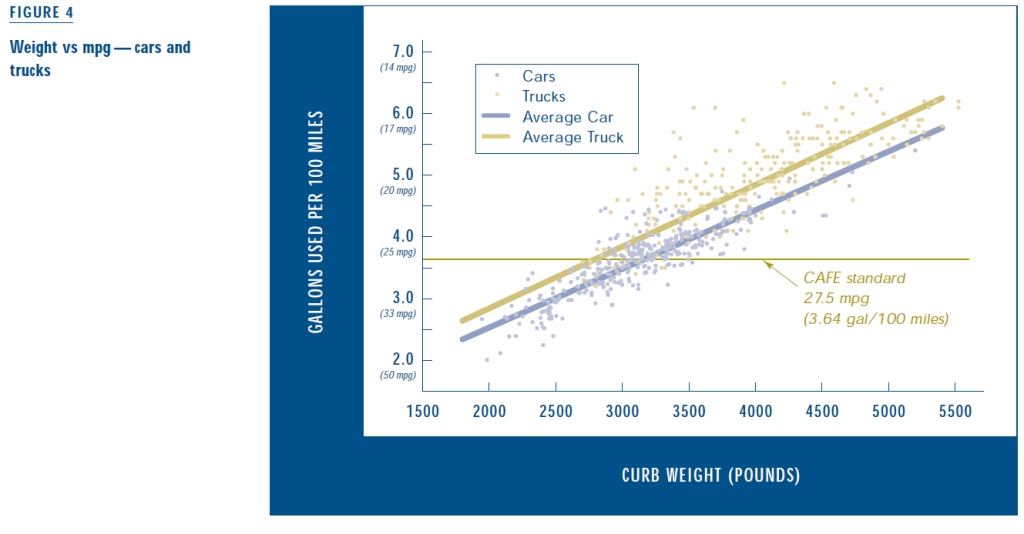
Figure 4 adds data for light-duty trucks. Again there is a strong relationship between weight and fuel consumption, though with somewhat more outliers than in the car graphs. The average truck data are shown as a gold line, which is nearly parallel to the average car line, and only 2.5 mpg higher.
The Safety-Enhanced CAFE Standard
It is possible to combine the current CAFE system with weight-based targets to preserve most advantages of each while eliminating most disadvantages. In particular, the combined measure should improve safety; hence it is called the “Safety-Enhanced CAFE” (SE-CAFE) standard. The Safety-Enhanced CAFE system creates a different kind of baseline for measuring compliance, and hence different incentives for manufacturers—incentives that move us toward some highly desirable goals.
The line in Figure 5 shows the SE-CAFE fuel consumption target: a single baseline used to measure performance deviations for both cars and trucks. For vehicles that weigh less than 4,000 pounds, the target is sloped upward like the weight-based targets. For those that weigh more than 4,000 pounds, the target is a horizontal line like the current CAFE standard.
In particular, SE-CAFE creates a strong set of incentives to improve the fuel economy of the heaviest vehicles. Under the current CAFE law, if a manufacturer wishes to offset the excess fuel consumption of a large vehicle, it can do so easily by selling a light vehicle: the vertical gap of the large vehicle (A) in Figure 2 is offset by the vertical gap of the small vehicle (B). But if the baseline is changed to SE-CAFE (Figure 5), the small vehicle does not generate a large credit because it is on the sloped portion of the baseline and its gap is measured with respect to the slope, not with respect to the horizontal line.
Some Implications
How would this proposal affect the different manufacturers? I computed a fleetwide compliance measure for each of the Big 3 manufacturers plus Honda and Toyota. How do they measure up to the SE-CAFE targets? Compliance ranged from three percent below the targets to six percent above. None of the major manufacturers begins with a large compliance deviation; it’s a relatively fair starting point.
SE-CAFE has a single set of targets for all vehicles, eliminating concerns about arbitrary truck/ car distinctions and their possible manipulation. For example, the popular PT Cruiser made minor design changes so it could be classified as a truck, which means it need meet only a 20.7 mpg standard, instead of the 27.5 mpg standard for cars. SE-CAFE eliminates the problem by eliminating distinctions between cars and trucks; all vehicles are treated the same.
There would be a small incentive for lightweight vehicles to be made heavier, and a large incentive for vehicles weighing more than the cutoff weight to be made lighter. Thus the variance in weight across the combined fleet should be lower, which would improve safety in car-to-car collisions.
The present position of the lines could serve as the initial baseline under the SE-CAFE system. It produces a combined car and truck fuel economy of 24.6 mpg (which is the overall car/truckfleet average for the model year 2000 fleet). To improve overall fuel economy in subsequent years, the horizontal portion of the baseline would be lowered while simultaneously reducing the slope of the lower portion of the baseline; the slope of the lower portion could also be adjusted to reflect the most cost-effective use of technology. Of course there should be atransition period to allow phase-in of the SE-CAFE system: manufacturers have already made plans based on existing CAFE standards, and they must be given time to redo their product plans.
Summary
The Safety-Enhanced CAFE Standard has several important advantages. While it is “only” a change in the measurement system, it creates
incentives that will reduce fuel consumption and increase safety of the overall vehicle fleet.
Further Readings
Environmental Protection Agency. Light-Duty Automotive Technology and Fuel Economy Trends, 1975 Through 2001. US EPA, Ann Arbor, Michigan. 2001.
David Greene. Transportation and Energy. Eno Transportation Foundation, Inc., Lansdowne, VA. 1996.
National Research Council. Effectiveness and Impact of Corporate Average Fuel Economy (CAFE) Standards. National Academy Press, Washington, DC. 2001.

